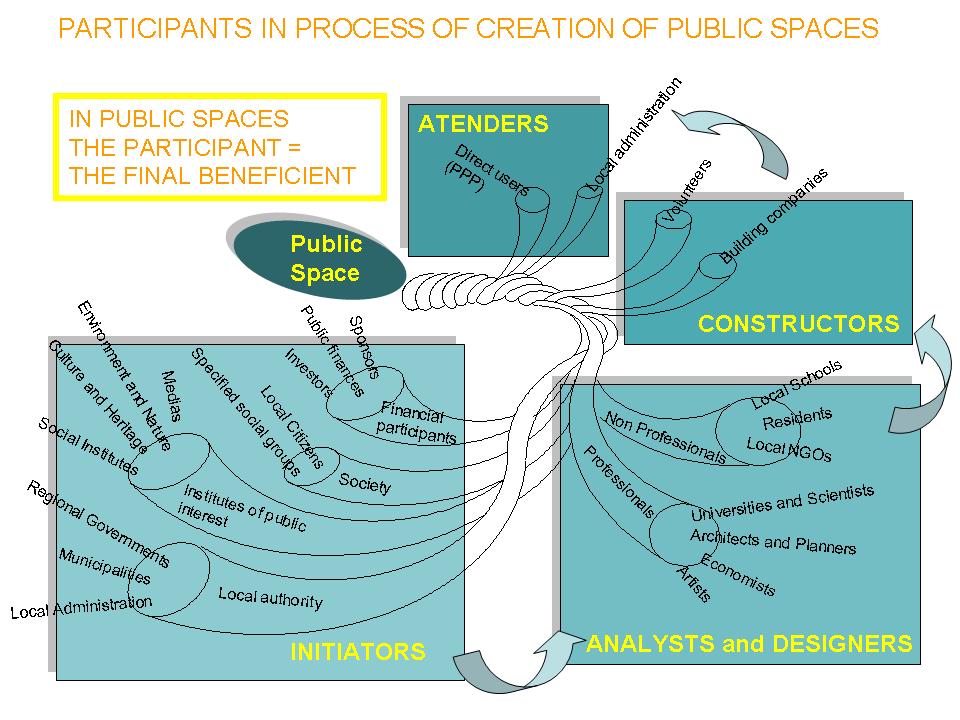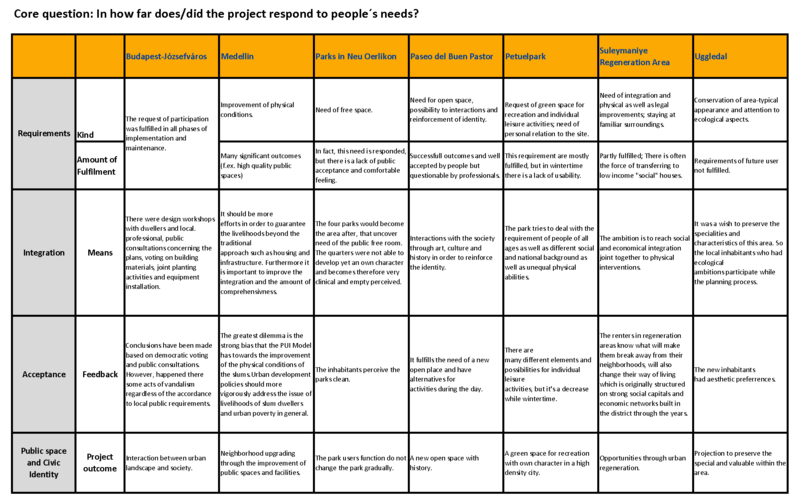Working Group Public Space and Civic Identity
Case Studies of this working group
The list includes all case studies categorised in this group and the respective answers to the first question "Rationale:Why is this case study interesting?"
Attention: this is a dynamic page list, do not edit this paragraph!
<DPL>
category=Working Group Public Space and Civic Identity mode=ordered include = #Rationale: Why is this case study interesting?
</DPL> Back to top
Core Questions of this Working Group
Core questions as identified during the first group meeting on December 3rd 2008:
- Who was involved in the participation process? (Agnieska, Harun)
- How was the participation process implemented (methods applied)? (Camilo, Andrew)
- In how far does/did the project respond to people's needs? (Liliana, Martina)
Notes:
- The names behind the questions identify those people that take up a kind of editor's responsibility for the questions. All group members are asked to integrate all questions into their case study report. The respective question editors will then compile the different answers and report back to the group plenary on December 19th.
- People who did not attend the session on 3rd of December may have additional proposals for core questions. Feel free to add these questions as proposals to the list above and discuss it via e-mail or using the discussion page.
- Please integrate the questions soon and try to deliver some draft answers before December 15th - otherwise it will become difficult to create a synthesis report for December 17th.
Synthesis of Core Questions
Who was involved in the participation process?
Agnieska , Harun
Answers of the Case Studies
<DPL>
category=Working Group Public Space and Civic Identity mode=ordered include = #Who was involved in the participation process?
</DPL>
Synthesis
How was the participation process implemented (methods applied)?
Camilo, Andrew
Answers of the Case Studies
<DPL>
category=Working Group Public Space and Civic Identity mode=ordered include = #How was the participation process implemented (methods applied)?
</DPL>
Synthesis
| Budapest-Józsefváros | Medellin | Parks in Neu Oerlikon | Paseo del Buen Pastor | Petuelpark | Suleymaniye Regeneration Area | Uggledal | |
| Initiation | Leaflets and local press – for promotion of process, Kick off meeting,Questionnaire | Public meetings - socialising and promoting the project and its process, Quantitative and qualitative surveys, Workshops and field visits (officials & community leaders) | Questionnaire in local newspaper and to people using the space, general, open questions | specific and limited questionnaire | |||
| Plan | Open meetings, surveys and interviews undertaken by students | Workshops – public, local officials, artist and professionals, interdisciplinary work | Workshops - women groups, professionals, school children- (formulated plan of area), Meetings – citizen groups | ||||
| Design | Presentation of plan based on above material, vote on material to be constructed | Workshops to design the use and characteristics of the public spaces (community in general), review of the designs (officials & community leaders). | General workshops,specific workshops (children, disabled), interdisciplinary | Workshops - women groups, professionals, school children, meetings – citizen groups | |||
| Implementation | Design and realisation of sitting-hills (schools, students, NGO’s), Public planting in the square | Local, community press and billboards informing about the projects, Labour force for the construction of the projects was mainly from the community | Artist collaboration | ||||
| Maintenance | Delegation of tasks to communities and institutions (in process) | Delegation of tasks to community and institutions, social programs and community activities have been established in the projects | Maintenance of several communal areas is responsibility of community groups |
Concluding thoughts:
- ...
- ...
- ...
.
.
.
In how far does/did the project respond to people's needs?
Liliana, Martina
Answers of the Case Studies
<DPL>
category=Working Group Public Space and Civic Identity mode=ordered include = #In how far does/did the project respond to people's needs?
</DPL>
Summary
Budapest-Józsefváros: The request of participation was fulfilled in all phases of implementation and maintenance. There were design workshops with dwellers and local professionals, public consultations concerning the plans, voting on building materials, joint planting activities and equipment installation.
Medellin: The improvement of physical conditions in the slum bore some significant outcomes, for example high quality public spaces. But it should be more efforts in order to guarantee the livelihoods beyond the traditional approach such as housing and infrastructure. Furthermore it's important to improve the integration and the amount of comprehensiveness.
Parks in Neu Oerlikon: The four parks have a high artistic quality and were made for creating free space. The Wahlen Park is also used as a school meadow and is accepted well. The MFO Park reminds of the original buildings, is designed in different levels and some attractions are temporary or long-term existing. The Oerliker Park is seen as worse integrated and the idea, that users affect a new appearance of the park, doesn’t work yet. The lower utilization leads back to the very far construction of the new quarter Oerlikon within 5 years. As a result there is a lack of development, less own character and clinical, empty feeling.
Paseo del Buen Pastor: It fulfills the need of a new open place, of having alternatives for activities as well as the possibility for interactions with the society through art, culture and history in order to reinforce the identity.
Petuelpark: It responds to the need of having a green space for recreation. There are many different elements and possibilities for individual leisure activities, but it's a decrease while wintertime. Works of art, individual designed places and furniture and the typical style of the park, fulfills the requirement of having a unique place with own character.
Suleymaniye Regeneration Area: The ambition is to reach social and economical integration joint together to physical interventions.
Sulzer Factory Area: This area is marked by its need for adaptability. Nowadays, the human were brought into focus and the space is used as place of congregation.
Uggledal: It was a wish of the planner to preserve the specialties and characteristics of this area. So the local inhabitants who had ecological ambitions participate while the planning process. But the new inhabitant had aesthetic preferences.
Analysis
Commonalities and important points: In all cases, they try to respond to people’s requirements and wishes, mostly by dint of public participation. As well, there is the aim to integrate people, whether trough the participatory process itself or through the level of acceptance and usage. Although the projects have/had different ways of integration, the goals to reach bear a resemblance to each other centered at the end outcomes. Furthermore, every place and park was made in order to improve living conditions (in the majority of by creating regeneration and recreation areas) and to identify people with its surrounding society.
Gaps and discrepances: In general, it’s not possible to fulfill all requirements, because one can’t cover the whole range of human needs. There will be always a lack of sufficiency. Besides, by planning for future users, you can only suppose what kind of persons will utilize it.
Unusual approaches: Case study Medellin: Upgrading social conditions by means of physical condition improvements. Case study Suleymanlye Regeneration Area: The ambition is to reach social and economical integration joint together to physical interventions. This unusual approach (for the western point of view) is caused by stronger physical, social and economical conditions, which are typical in some countries.
Main differences between the case studies: Different amount of fulfillment: There is a range of total completion until no one. Different ways to fulfill people’s requirements: Participation, Improvement of physical, economical or legal conditions, creation of free space and recreation areas, conservation of identity, activation of interactions, ecological and environmental ambitions, art and history,
Thematic clusters: Cluster 1: Amelioration of physical, social, economical and legal conditions Cluster 2: Creation of free space, recreation, regeneration Cluster 3: Preserving identity and evocation of personal relations to the site



